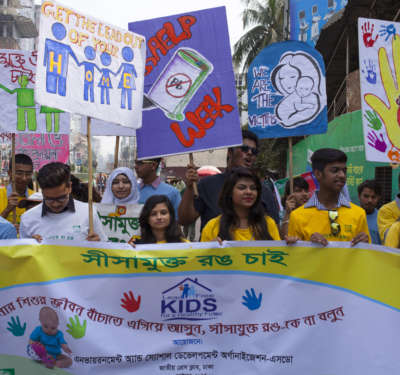Lack of lead poison awareness among Bangladeshi women
Women in Bangladesh lack awareness about lead poisoning regardless of their level of education.
Published online 30 May 2016

Bangladeshi youth at a rally calling for the elimination of lead from paints.
© ZUMA Press, Inc. / Alamy Stock Photo
Women of childbearing age from various parts of Bangladesh living in the capital city Dhaka were surveyed about their levels of awareness and potential behaviours that could lead to lead exposure and toxicity. The study, conducted by researchers from BRAC University in Dhaka, found that the women surveyed, regardless of their educational level, lacked awareness about the potential sources of lead poisoning1. Women who had an education beyond the secondary level claimed to be aware of the harmful effects of lead but this was not reflected in their everyday behaviours.
Lead poisoning occurs when the metal accumulates in the body over a long period of time. Unborn and young children are especially vulnerable because they absorb up to five times as much ingested lead as adults from a given source. This can affect their physical and mental development. Lead poisoning can lead to learning difficulties, fatigue, memory loss, mood disorders, miscarriages and premature births.
Although many countries around the world, including Bangladesh, have introduced policies to reduce potential sources of lead exposure, their implementation is often lacking. Common sources of lead exposure in Bangladesh include soil fertilizers, paints, solder used in food cans, some spices, and traditional cosmetics.
The survey was conducted among 114 women of childbearing age. Approximately half the group received an education above the secondary level, while the rest did not. Levels of awareness about potential sources of lead toxicity were generally low across the whole group. Only 22% of the more educated group said that they were aware that paint could contain lead.
The study also found that because of their more privileged lifestyles, the more educated women were more exposed to certain lead sources than the less educated group. For example, only 16% of the less educated women lived in painted houses while all the women in the more educated group did. Also, the more educated women were more likely to use ayurvedic or herbal medicines, a potential source of lead exposure in Bangladesh, than the less educated group. On the other hand, the less educated women were more exposed to lead through gardening, eating visible fat on cooked meat, and using traditional cosmetics.
“Prevention of unregulated sources of lead poisoning is important,” the study’s authors write in the Journal of Local and Global Health Sciences. They recommend the development of awareness programmes, particularly among women of childbearing age.
Reference
- Neelotpol, S. & Andalib Hia, R. Lead exposure of Bangladeshi women at childbearing age: does mother’s education reduce fetal risk factors? J. Local Glob. Health Sci.2016, 1 (2016). | article
DOI: 10.1038/qsh.2016.111

